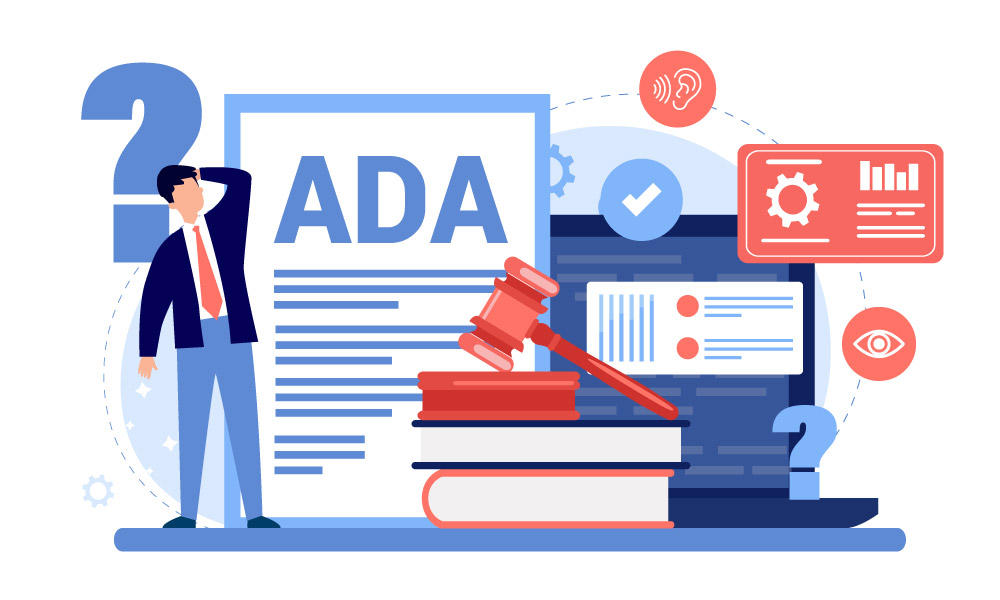
Maintaining an ADA-compliant website helps protect your business against lawsuits and fines in addition to providing needed accommodations for your potential customers.
The federal Americans with Disabilities Act (ADA) is often associated with physical locations and accommodations certain businesses must make for people with disabilities. These accommodations typically include, for example, wheelchair accessibility and the use of Braille for customers who are visually impaired. However, the ADA also extends to the digital realm, requiring businesses to ensure web content is accessible to all users.What does an ADA-compliant website look like, exactly? There are no clear ADA regulations that spell out exactly what compliant web content is, but businesses that fall under ADA Title I or ADA Title III are required to develop a website that offers "reasonable accessibility" to people with disabilities.
Is Your Website ADA Compliant?
Failure to create an ADA-compliant website could open a business to lawsuits, financial liabilities and damage to your brand reputation.What is ADA Website Compliance?
The ADA, which was passed in 1990, prohibits discrimination against those with disabilities, ensuring they have the same rights and opportunities as those without. The act covers all sectors, from jobs and schools to transportation and public/private places open to the public.In 2010, the U.S. Department of Justice passed the Americans with Disabilities Act Standards for Accessible Design, mandating all electronic and information technology, like websites, be accessible to those with disabilities, like vision impairment and hearing loss. Title III of the Americans with Disabilities Act (“ADA”) mandates that public accommodation must be provided to disabled persons to allow for the “full and equal enjoyment” of the related privileges, goods, services, advantages, and accommodations as those provided to able-bodied persons. The owner of any business is responsible for making sure those accommodations are made with “reasonable modification.” The ADA makes it very clear that a business that does not provide for that accommodation is engaging in unlawful discrimination 42 U.S.C. section 12182(b)(2)(A)(iii). Source: National Law Review
What is WCAG Compliance?
Web Content Accessibility Guidelines (WCAG) are technical guidelines developed by the Worldwide Web Consortium (W3C) with the goal of providing a single shared standard for web content accessibility that meets the needs of individuals, organizations, and governments internationally. A website that is WCAG compliant will satisfy most requirements required for ADA Title III, Section 508, Canada ACA & AODA, and EU compliance.While the ADA doesn't offer set guidelines for website compliance, many organizations follow the Web Content Accessibility Guidelines (WCAG). This isn't a legal requirement, rather a reference point for organizations looking to improve their digital accessibility.
There are three versions of WCAG: 1.0, 2.0 and 2.1. Version 2.0 replaced version 1.0, while 2.1 exists as an extension of 2.0. There are also three levels of conformance: A (bare minimum level of accessibility), AA (target level of accessibility meeting legal requirements) and AAA (exceeds accessibility requirements).
The WCAG 2.1 guidelines ensure your web content is:
Perceivable: Content is presented in an easily perceivable manner. Examples include offering alternatives to text, such as audio alternatives or assistive technology, that allow sight-impaired individuals to perceive your website's content.
Operable: Navigation is easy to operate. Examples include offering keyboard accessibilities so users with disabilities can easily navigate your website and access content.
Understandable: Content is easy to understand. Examples include making content readable and predictable, and offering input assistance if needed.
Robust: Your website's content can be interpreted by various devices and platforms. For example, you want to ensure content is compatible with user agents like assistive technologies. Meeting these standards improves the accessibility of your website to individuals with vision or hearing impairments, or those with cognitive, language, or learning disabilities. If you follow these guidelines to at least level AA, ADA compliance shouldn't be an issue for your company.
Improving the accessibility of your company's website to individuals who are visually impaired, hearing impaired, or those who must navigate by voice can be done multiple ways, including some that are not immediately obvious.
How to develop an ADA-compliant website
Improving the accessibility of your company's website to individuals who are visually impaired, hearing impaired, or those who must navigate by voice can be done multiple ways, including some that are not immediately obvious."A business's IT/Marketing department must design its website so that those who are disabled can access it easily, for example, if someone is sight impaired, the web designer can install certain technologies, such as screen readers, in which a voice reads the text on the screen back to the web visitor. Refreshable Braille text for touchscreens can also be used.
In lieu of any regulatory guidance, business owners should look to the regulations that govern federal agencies' websites and related case law to gain an understanding of what compliance might be.
There is no regulatory guidance on this issue – yet – for commercial entities, thus, there are no regulations or statutes that define 'ADA compliance' as to websites. There are, however, requirements for federal websites, as well as some detailed legal decisions that can be used as guidance, including opinions that have held that 'reasonable' accessibility is key.
Here are some common ways businesses can address accessibility issues associated with their web content:
Create alt tags for all images, videos and audio files. Alt tags allow users with disabilities to read or hear alternative descriptions of content they might not otherwise be able to view. Alt tags describe the object itself and, generally, the purpose it serves on the site.
Create text transcripts for video and audio content. Text transcripts help hearing-impaired users understand content that would otherwise be inaccessible to them.
Identify the site's language in the header code. Making it clear what language the site should be read in helps users who utilize text readers. Text readers can identify those codes and function accordingly.
Offer alternatives and suggestions when users encounter input errors. If a user with a disability is encountering input errors because of their need to navigate the website differently, your site should automatically offer recommendations as to how visitors can better navigate to the content they need.
Create a consistent, organized layout. Menus, links and buttons should be organized in such a way that they are clearly delineated from one another, and are easily navigated throughout the entire site. There are other ways businesses can create an accessible website for users with disabilities. Consulting with an attorney who specializes in disability law is a must for businesses concerned about ADA compliance, but if you're looking for a place to get started on your own, reading the ADA requirements is an important first step.
Liability for failure to comply
Failing to comply with the ADA means your business is susceptible to lawsuits, and the costs of an ADA lawsuit add up quickly.Other than a business being forced to comply, which is costly, the business will have to pay attorneys' fees, which can be tens of thousands of dollars. Depending on the state, the business owner can be looking at a $50,000 bill.
Beyond regulatory consequences, failure to provide accessibility to users with disabilities means losing out on business. If users cannot navigate your website, you're missing sales opportunities. Further, ADA compliance makes it easier for search engines to crawl and index your website, pushing it up in the rankings and getting your web content in front of more users.
If users with disabilities struggle to complete forms and make purchases on your website, you could be losing out on potential customers, plus, many of the rules for ADA compliance also help websites with search engine optimization."
While ADA website compliance is a bit subjective now, it's not too difficult to discern what is meant by "reasonable accessibility."
By making a good-faith effort to achieve reasonable accessibility for users with disabilities, businesses can get ahead of the regulatory curve in developing a compliant website and avoiding potential lawsuits. Moreover, designing a compliant website can lead to more sales and better ranking on search engines.

